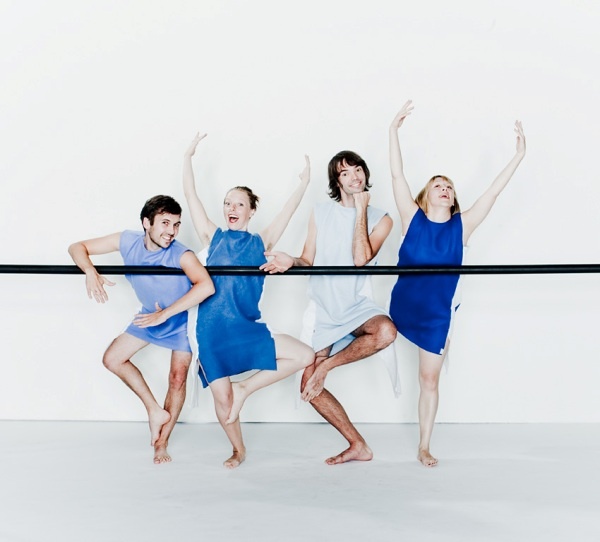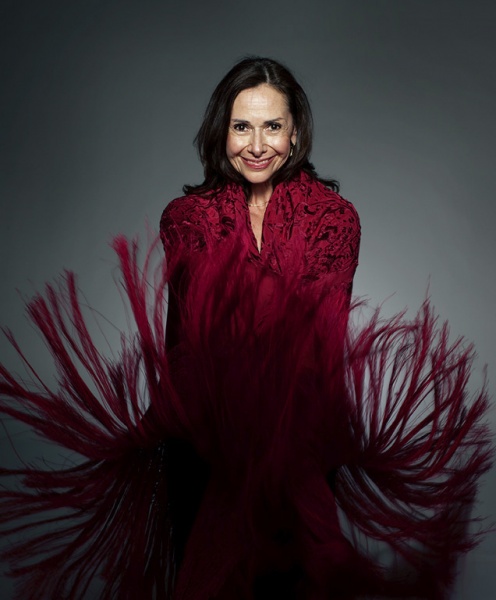Some Thoughts on the 2010 Choreographers’ Evening
Lightsey Darst reflects on the Walker's 2010 dance showcase, curated by Susana di Palma. Amid the bright spots and crowd-pleasing moments, she found herself wanting more -- more daring, more innovation, more virtuosity -- from the night's performances.


LET’S START WITH THE DRESS worn by this year’s curator of Choreographers’ Evening, flamenco diva Susanna di Palma: a slinky one-shouldered column of viridian and silver sequins, it cast shimmering pools and dancing sparks at her feet and scattered disco stars all over the Walker’s McGuire Theater. For the dress, di Palma could not have chosen better. Its glitz exactly fits the mood of Choreographers’ Eve, when the Twin Cities’ dance community glams up, gets a little festive, and takes over the Walker. But I’m afraid di Palma’s dress was the brightest thing going this year.
The pieces I liked best were three modest rearrangements of the dance “game.” I can most effectively explain what I mean by telling you about the pieces. Ballet hero James Sewell prefaced his short solo, Bodypuzzle, with a series of exercises for the audience: try making a line (up and down) in the air with one hand, over and over, while making a right triangle with the other hand; try tracing a circle with one hand and a square with the other. Sewell then turned these little exercises, which make one’s head hurt as they (let’s hope) ward off dementia, into a vertiginous display of coordinated uncoordination — like a traffic cop on crack, a sea creature, an architect describing fantastic houses for contortionists to live in. Knowing what he was up to, having just tested these neural pathways in ourselves, the audience could appreciate Sewell’s foray into this uncharted arena of virtuosity.
John Munger‘s clever Trayage takes place almost entirely on a tray table with his two hands as the dancers, who pound, race, flounce, and scratch along to some stirring Sousa. Munger’s expressive face and upper body cavort and sway along as well, giving an overall impression of a man carried away at a concert, or on his commute, dancing as much as he can in a confined space. This is a quite modest shift to the usual terms of dance (upper body only), but I like how Munger illuminates a boundary then creates a little gem within it, musical, fluent, fun, and surprisingly inventive despite (or because of) its limits.
Black-clad, the three dancers of Peter O’Gorman‘s Serif don’t draw the eye; instead, it’s the stiff whisks they wield that dance, as they make curt brush-sounds like amplified calligraphy. This is, as someone pointed out to me, a little like Blue Man Group, but it’s unusual in the Twin Cities; it’s well-done here, oddly satisfying and soothing, particularly when the trio pick up longer whisks that sound like sleep-breathing, or scythes moving through summer grass.
Beyond these three pieces, most of the evening’s work stayed securely within established bounds — not that coloring in the lines is always dull. Alanna Morris‘s solo, Dreams, doesn’t breach the modern dance envelope, but Morris makes interesting choices within that field, walking off abruptly after a muscular movement passage, walking back on, switching from gesture to dance, from dance to silence. She doesn’t need the opening slideshow, which too heavily freights the work with images of protest, and she could drop one or two musical switches, but altogether Morris creates a compelling, slightly mysterious work that suggests what is not quite in reach. It helps that Morris gives a sense of purpose to each motion; she makes you trust that her dance has an inside (I didn’t see Renée Copeland’s turn in the part at the earlier showing of this piece).
The evening was awash in solos: besides Sewell’s, Munger’s, and Morris’s, we got Paulino Brener‘s Credo, in which he stalks impressively around stage (Brener must be over six-and-a-half feet tall, so everything he does is impressive), occasionally doing a little foot-stomping apparently derived from Argentinian chacarera, but mostly setting up for some grand event that never quite happens. We also got For She — A Little Found Object, from Carl Flink, danced by a female soloist (Crystal Runk or Julie Brant McBride). Live spotlights give a sense of voyeurism as we watch the contortions of this doomed character in her little room (in the asylum, I imagined). For She is full of thought and work, but the unrelenting seriousness and lack of overall motion (she starts stuck, she ends stuck) left me glazed over while it was going on. I wanted less — less, to make more room for breath and dreams.
______________________________________________________
I can have my ideas confirmed at home. When I go out, I want to see something that disorients, that changes my mind, that alters my experience.
______________________________________________________
SuperGroup‘s Spring Dance Unrated couldn’t leave anyone complaining of excessive seriousness — nor could it leave anyone wanting less, as the performers gradually stripped garment after garment until they were doing their silly Duncan-esque movement in practically nothing, prancing and spinning and hopping very Isadorably.
Fast-forward Duncan’s sprightly nature-derived dance a hundred years or so and you get Jim Lieberthal‘s Blue Channel Rivulets, a modern sextet that is partly inspired, he says, by dolphins. So, what do I have against dolphins? Perhaps it’s the way people get all puddly-gooey about them, as if their insides have turned to marshmallow fluff. Still, Lieberthal does not fall into a complete dolphin coma here, and the piece turns out to be mostly a way to showcase some lovely dancers. Any excuse to see Christine Maginnis is a good one, and the rest of the dancers are a pleasure, too, as they wave and glide and roll through the dance — especially Brian Evans, who can somehow throw his entire body into the air and yet land without a sound.
Perhaps I should say a little more about Evans. Being able to jump soundlessly is nice, and Evans has lots of other nice tricks up his sleeve, but what I like about him is that he doesn’t ever do the trick just for itself. Like Alanna Morris, Evans gives his dance an inside. In the evening’s other group modern work, Luke Olson-Elm‘s The Evaporation of Time, I saw Katherine Lung do that, but she had to work against the choreography, which is all emo gesture (her hand to his heart, strained muscles in extensions, “we’re trying” pouring off the stage) and pop-up tricks (why is he standing on his hands now?). But I should go a little easier on Olson-Elm. He’s just out of college, just starting as a choreographer, and this piece shows his love of the form, which is all one has at first (and at last, too, I suppose, but that’s a ways off).
Love of dance clearly motivates Whitney McClusky and Fodé Bangoura‘s African La Ronde des Sons, as well as Christ UP Dance Crew’s Christ UP Movements. I lump these two together because they exhibit a similar level of skill: some deft moves, some good moments, but overall not the best the Twin Cities can offer in African or hip-hop dance. I’m also lumping them together because the audience response was the same for both: fervent (and to my ear, strained) enthusiasm. Twin Cities audiences react with lukewarm applause to lukewarm modern dance; certainly we’ve seen enough African and hip-hop now to have taste in these categories as well.
Two duets filled out the evening, Cross-Pollination from Gerry Girouard and Rebecca Abas (Bodytalk), and Search for Country from Giselle and Dario Mejia (Curio Dance). Cross-Pollination mixes tango and what-not in a partner dance that is sometimes dull, sometimes awkward. The heat’s not on. The Mejias (brother and sister) are attractive performers, but their dance — simply structured, frontal, using familiar steps — left them looking small and a bit lost on stage. They, like many of the performances here, need another dimension.
As always, the Walker performing arts blog is a good barometer of the evening; as I write this, it’s utterly silent. No one, apparently, was hacked off, confused, outraged, etc, by di Palma’s selections. Why, you might ask, is that a bad thing? A woman behind me kept saying “Yes!” throughout the show; after a while I wanted to see the dance that would make her say “No!”. Perverse? Maybe. But I can have my ideas confirmed at home. When I go out, I want to see something that disorients, that changes my mind, that alters my experience. When you know dance can do that, why would you settle for anything less?
______________________________________________________
Noted performance details:
Choreographers’ Evening 2010, curated this year by Susana di Palma (Zorongo Flamenco Dance Theatre) took place at the Walker Art Center on November 27 with two shows, at 7 pm and 9:30 pm.
______________________________________________________
About the author: Originally from Tallahassee, Lightsey Darst is a poet, dance writer, and adjunct instructor at various Twin Cities colleges. Her manuscript Find the Girl has just been published by Coffee House; she has also been awarded a 2007 NEA Fellowship. She hosts the writing salon, “The Works.”